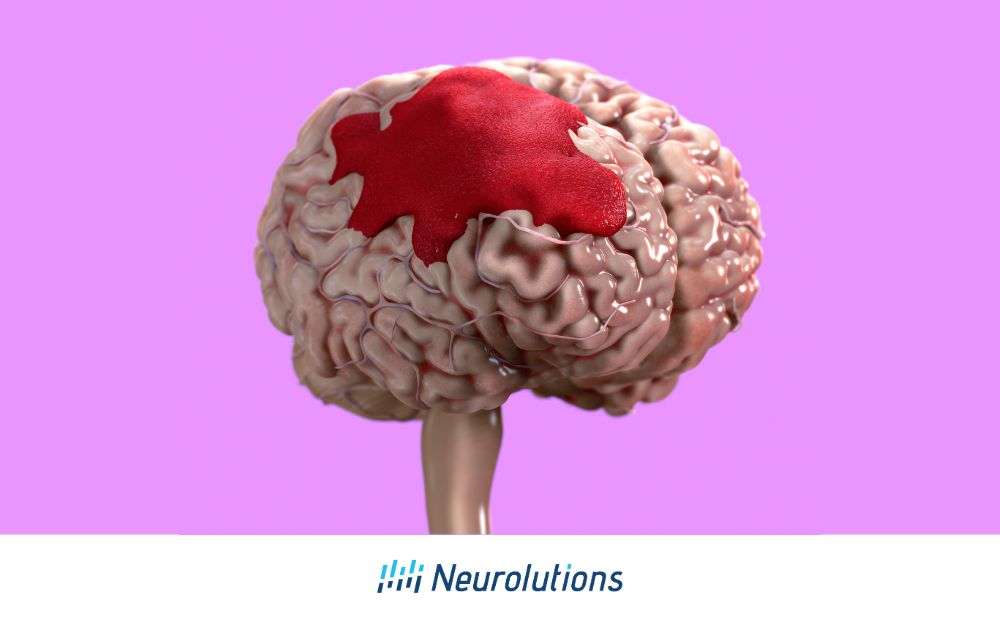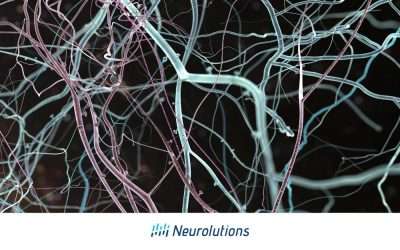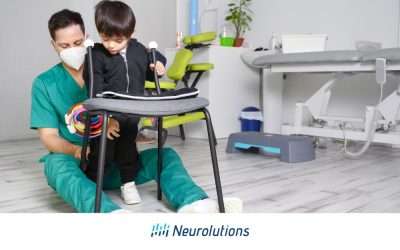Brain bleeds are dangerous and can affect brain functions. While most strokes are caused by clots (ischemic), a significant portion results from bleeding in the brain (hemorrhagic), which have a higher fatality rate.
Bleeding inside the brain is very serious. The severity and location of the bleeding can affect body and mental functions like moving, thinking, and even breathing. While 87% of all strokes are ischemic – caused by a clot in the blood that travels to the brain or forms in a blood vessel in the brain – around 13% are hemorrhagic strokes caused by bleeding within the brain (1). The fatality rate is far higher for hemorrhagic stroke victims than for ischemic stroke victims, but a brain bleed for any reason is dangerous.
The purpose of this article is to describe the differences between experiencing a stroke and brain bleed, as well as their symptoms, causes, treatment, and effect on normal functioning.
Understanding Stroke
Strokes, caused by clots or bleeding in the brain, contribute to brain cell and nerve fiber damage. This damage contributes to muscle weakness, paralysis, cognitive and emotional impairments. Common causes of stroke include high blood pressure, artery issues, heart conditions, and diabetes.
A stroke often damages or kills brain cells as well as harm the nerves in the brain. Nerve cells and neural pathways in the brain that are damaged impede the “messages” sent by the brain to the spinal cord. In turn, the muscles that receive these nerve messages are negatively impacted, often resulting in paralysis or weakness in the affected muscles. Both ischemic and hemorrhagic stroke can result in injury to the nerves and neural pathways that enable muscle groups to work (2).
While the primary causes of both ischemic and hemorrhagic stroke are high blood pressure, hardening of the arteries, heart arrhythmias, and diabetes, hemorrhagic stroke can also be also caused by:
- Ruptured cerebral aneurysm: This occurs when an area in a brain artery bulges and then bursts. The underlying cause of this is typically chronically-high blood pressure (3).
- Severe concussion (4): A mild traumatic brain injury resulting from a blow or jolt to the head, causing temporary disruption of normal brain function.
- Arteriovenous malformation (AVM): A congenital (present from birth) malformation forms a tangle of blood vessels in the brain.This causes blood flow to go around normal brain tissue and move directly from arteries to veins (5).
Strokes typically affect one of the two hemispheres of the brain, so paralysis and weakness on one side of the body is common. Left-hemisphere strokes are more likely to result in speech/language comprehension impairments (6). Hemorrhagic strokes are more likely to affect both hemispheres, and thus generally result in a higher degree of paralysis and level of overall disability.
Understanding Brain Bleed
Brain bleeds, not always due to strokes, can result from head injuries, tumors, or genetic disorders. Various types classified by their location and cause, focusing on prevention for high-risk individuals.
Not every brain bleed is caused by a stroke. Traumatic injuries that impact the head such as motor vehicle accidents, violent attacks, and sports injuries, can prompt a brain bleed. Likewise, brain tumors and genetic disorders that impair normal blood-clotting can lead to a brain bleed. The most common cause of a brain bleed is intracerebral hemorrhage, which involves bleeding within the brain tissue itself. The four classification types of intracranial hemorrhage are (7):
Epidural hemorrhage:
This classification of hemorrhage is typically caused by blunt trauma or a puncture wound to the head.
Subdural hemorrhage
Subdural hemorrhage can also be caused by trauma to the head, but can also occur spontaneously due to congenital blood vessel abnormalities in the brain.
Subarachnoid hemorrhage
This is often the result of a ruptured brain aneurysm, but can also be caused by non-aneurysm blunt trauma, puncture wound to the head, or congenital blood vessel abnormality resulting in bleeding.
Intraparenchymal hemorrhage
Intraparenchymal hemorrhage involves generalized bleeding into brain tissue caused most often by a ruptured aneurysm or AVM, as well as infection, trauma, and conditions that impact clotting functions of the blood.
Both benign and cancerous brain tumors can result in bleeding in the brain. Additionally, the surgeries that are performed to remove tumors, correct an AVM, or repair brain tissue can also result in a brain bleed. Since hemorrhagic strokes are a major cause of brain bleeding, preventing a hemorrhagic stroke is a major focus in people with high stroke risk. Therefore, preventing or controlling high blood pressure and lowering the risk for head injuries are among the most frequent preventive measures employed by healthcare providers.
Cognitive Impacts of Stroke and Traumatic Brain Injuries (TBIs)
Both strokes and Traumatic Brain Injuries (TBIs) impair cognitive functions, including memory and language skills. Additionally, they can affect mood, often resulting in survivors experiencing symptoms of depression or anxiety.
Both stroke and TBI can disrupt or damage the communication pathways between nerve cells in the brain, as well as between the brain and the rest of the body. This can interfere with the ability to concentrate, retain memory, speak and/or understand language, and problem-solving. It can also negatively affect eyesight, hearing, taste, and smell. One of the most common impacts of even mild strokes and mild TBIs is prolonged fatigue which can reduce the motivation to fully participate in prescribed rehab activities.
In addition, the brain’s normal release of chemicals that boost mood can also be impaired, with 30% of stroke survivors experiencing persistent depression (8). Likewise, people who have experienced TBIs have a higher likelihood of persistent depression and anxiety (9).
Differences between Brain Bleed and Stroke
Brain bleeds can be a part of or cause strokes, but non-stroke bleeds are more common in younger people. Treatment varies based on the injury type.
Brain bleeds and strokes are related because bleeding in the brain can be part of a stroke or even cause it. A brain bleed that is not caused by a stroke is more likely to occur in a younger person, whereas strokes are more likely to occur in people aged 60 and older.
Additionally, in cases where a traumatic head injury leads to a brain bleed, a fractured skull may also occur and potentially cause injuries to blood vessels and other regions of the brain from the bone fragments. The medical treatment for a hospitalized individual with a traumatic brain injury resulting from a skull fracture can differ significantly from the standard treatment for someone hospitalized due to a stroke
Symptoms of Brain Bleed and Stroke
Common symptoms include paralysis, vision problems, confusion, dizziness, and, in cases of hemorrhagic stroke, severe headaches.
The following are some common symptoms of a brain bleed or stroke (10):
- Paralysis, weakness, or numbness on one side of the face and body
- Sudden onset of blindness or double-vision (also called “seeing double”)
- Sudden onset of confusion
- Lightheadedness and dizziness
- Nausea and vomiting
For brain bleeds caused by a stroke, a common initial symptom is often a severe headache.
Diagnosis and Treatment of Brain Bleed and Stroke
Diagnosis typically involves the use of CAT scans, MRI scans, and cerebral angiography. Treatment focuses on halting the bleeding and addressing the underlying cause, which may involve surgical intervention for certain types of bleeds.
Besides a patient’s medical history and examination, CAT scans and MRI scans are often utilized in diagnosing a stroke. When hemorrhagic stroke or other type of brain bleed is probable, the following three tools are utilized:
- Computed Tomography (CT or CAT) Scan
- Magnetic Resonance Imaging (MRI) Scan
- Cerebral Angiography: a procedure used to see how blood flows through the brain
With these specialized scans, doctors can find out where and why the brain is bleeding and decide how to treat it.
Stopping the bleeding is a first-line focus of treatment for a hemorrhagic stroke or brain bleed. In a hemorrhagic stroke, lowering blood pressure to a normal level and administering blood-clotting medication are often the earliest treatments. For other types of brain bleeds, surgery may be required. If an AVM is the cause of the brain bleed, the AVM-caused bleed may be addressed by (11):
- Surgical repair of the AVM
- Block blood flow to stop the bleeding by injecting a substance into the AVM blood vessels
- Radiation to shrink the blood vessels of the AVM
Fortunately, fewer than 4% of people with this disorder experience a brain bleed due to their AVM (12).
In conclusion, treatment for a brain bleed varies and is dependent upon its actual cause.
Rehabilitation after a Brain Bleed or Stroke
Rehabilitation, often requiring occupational, physical, and speech therapy, aims to regain lost motor skills, address speech and cognitive deficits, and works on increasing independence with daily activities. The recovery timeline varies depending on factors such as the type of stroke, its location within the brain, and its severity in each individual.
Occupational (OT) and/or physical therapy (PT) is crucial for recovering from a brain bleed or stroke, focusing on restoring motor skills and addressing any paralysis or weakness. Passive exercises might be the start for those hospitalized, leading to more active rehabilitation exercises as recovery progresses. People who have had hemorrhagic strokes or traumatic brain injuries might face more severe challenges, including paralysis on both sides of their body, due to multiple brain injuries.
Speech and language pathologists (SLPs) play a crucial role in the rehabilitation of individuals experiencing speech or language comprehension difficulties post-stroke. They utilize various activities, including “brain health” games and social interaction exercises, to enhance cognitive functions such as memory and concentration.
Recovery time can vary significantly, with hemorrhagic stroke survivors potentially facing a longer path to regain full functionality due to the extensive brain damage. The disability rate at three years following a stroke is 42.6% among ischemic stroke survivors and 65.3% among hemorrhagic stroke survivors (13). Rehabilitation strategies must be personalized, taking into account the overall health and specific injuries of the survivor to best support their recovery journey.
Prevention of Brain Bleed and Stroke
Preventive measures include controlling high blood pressure, maintaining a healthy weight, making lifestyle changes, and using safety measures like seatbelts and helmets to lower the risk of brain bleed and stroke.
Chronic high blood pressure is the primary cause of hemorrhagic stroke. In addition, obesity is strongly linked to developing both high blood pressure and Type 2 Diabetes. Since diabetes increases the risk for stroke, public health prevention efforts aimed at preventing Type 2 Diabetes should be taken seriously.
If a young or middle-aged adult has a Body Mass Index (BMI) over 25, it is recommended that they engage in a weight loss program to reduce their BMI to between 18.5 and 25. Doing so may help prevent the risk of future ischemic or hemorrhagic stroke later in life, particularly associated with Type 2 Diabetes (14).
To prevent brain bleeds and strokes, it’s crucial to make lifestyle changes, including adopting a healthier diet and quitting smoking. The annual incidence of TBIs resulting from automobile accidents is 4.1% among passengers wearing a seatbelt, compared to 10.4% among those not utilizing a seatbelt. (15). For motorcyclists, wearing a helmet is widely-recognized as decreasing the likelihood of sustaining a brain injury in a crash. For elderly people, one brain injury prevention strategy is to prevent slips, trips and falls in the home environment by removing slippery rugs and similar hazards.
Conclusion
Brain bleeds and strokes can make it hard to do things independently, lowering quality of life. There is overlap between brain bleed and stroke in that hemorrhagic stroke is caused by bleeding in the brain. In contrast to ischemic strokes that are caused by blood clots, the bleeding in hemorrhagic strokes is highly linked to an increased risk for stroke-related death. For individuals experiencing Traumatic Brain Injuries (TBIs) resulting from blunt head trauma or other causes, their injury can lead to limb paralysis or weakness, and it is also considered a risk factor for stroke
Due to their different causes, ischemic stroke is medically treated differently than hemorrhagic stroke or other types of brain bleeds. However, OT and/or PT can be helpful to both stroke and brain bleed-survivors to restore lost motor skills.
Negative cognitive and mood changes can occur as a result of both stroke and brain bleeding, emphasizing the importance of addressing cognitive function and mood in rehabilitation efforts. Taking these factors into account and making lifestyle changes to prevent brain bleeding and strokes can significantly reduce the likelihood of these injuries occurring.
References:
- Johns Hopkins Medicine. Types of Stroke. Webpage: https://www.hopkinsmedicine.org/health/conditions-and-diseases/stroke/types-of-stroke#:~:text=About%2087%25%20of%20all%20strokes,of%20all%20strokes%20are%20hemorrhagic.
- Centers for Disease Control (CDC). About Stroke. Webpage: https://www.cdc.gov/stroke/about
- American Stroke Association. Hemorrhagic Stroke. Webpage: https://www.stroke.org/en/about-stroke/types-of-stroke/hemorrhagic-strokes-bleeds
- Liu SW, Huang LC, Chung WF, et al. (2017). Increased Risk of Stroke in Patients of Concussion: A Nationwide Cohort Study. International Journal of Environmental Research and Public Health 14(3): 230. Webpage: https://www.ncbi.nlm.nih.gov/pmc/articles/PMC5369066/
- American Stroke Association. Hemorrhagic Stroke. Webpage: https://www.stroke.org/en/about-stroke/types-of-stroke/hemorrhagic-strokes-bleeds
- University of California, San Francisco (UCSF), Weill Institute for Neurosciences, Memory and Aging Center. Dementia and You – Speech & Language. Webpage: https://memory.ucsf.edu/symptoms/speech-language#:~:text=Stroke%20%26%20Injury,have%20left%20sided%20brain%20injuries.
- Tenny S, and Thorell W. (Last Update: February 13, 2023). Intracranial Hemorrhage. In: StatPearls [Internet]. StatPearls Publishing: Treasure Island, FL. Webpage: https://www.ncbi.nlm.nih.gov/books/NBK470242/
- Choi HL, Yang K, Han K, et al. (2023). Increased Risk of Developing Depression in Disability after Stroke: A Korean Nationwide Study. International Journal of Environmental Research and Public Health 20(1): 842. Webpage: https://www.ncbi.nlm.nih.gov/pmc/articles/PMC9819798/#:~:text=Stroke%20survivors%20had%20a%205,%25%20CI%204.89%E2%80%935.16).
- Al-Kader DA, Onyechi CI, Ikedum IV, et al. (2022). Depression and Anxiety in Patients With a History of Traumatic Brain Injury: A Case-Control Study. Cureus 14(8): e27971. Webpage: https://www.ncbi.nlm.nih.gov/pmc/articles/PMC9481205/#:~:text=About%2029%25%20of%20the%20patients,the%20only%20two%20healthy%20controls.
- New York-Presbyterian Hospital. Neurology Services. Brain Hemorrhage. Webpage: https://www.nyp.org/neuro/brain-hemorrhage
- National Library of Medicine, MedlinePlus. Stroke. Webpage: https://medlineplus.gov/stroke.html
- Johns Hopkins Medicine. Arteriovenous Malformations. Webpage: https://www.hopkinsmedicine.org/health/conditions-and-diseases/arteriovenous-malformations#:~:text=Fewer%20than%204%20percent%20of,percent%20of%20people%20with%20AVMs.
- Lv Y, Sun Q, Li J, et al. (2021). Disability Status and Its Influencing Factors Among Stroke Patients in Northeast China: A 3-Year Follow-Up Study. Neuropsychiatric Disease and Treatment 17: 2567-2573. Webpage: https://www.ncbi.nlm.nih.gov/pmc/articles/PMC8357400/#:~:text=from%20inpatient%20rehabilitation.-,The%20proportion%20of%20post%2Dstroke%20patients%20with%20disability%20decreased%20from,that%20reported%20in%20most%20studies.
- Shiozawa, Masahiro, et al. “Association of Body Mass Index with Ischemic and Hemorrhagic Stroke.” Nutrients, vol. 13, no. 7, July 2021, p. 2343. PubMed Central. Webpage: https://doi.org/10.3390/nu13072343.
- Han GM, Newmyer A, and Qu M. (2015). Seat belt use to save face: Impact on drivers’ body region and nature of injury in motor vehicle crashes. Traffic Injury Prevention 16(6): 605-610. Webpage: https://pubmed.ncbi.nlm.nih.gov/25671580/#:~:text=Results%3A%20Seat%20belt%20use%20significantly,%3B%2035.5%25%20seat%20belt).




